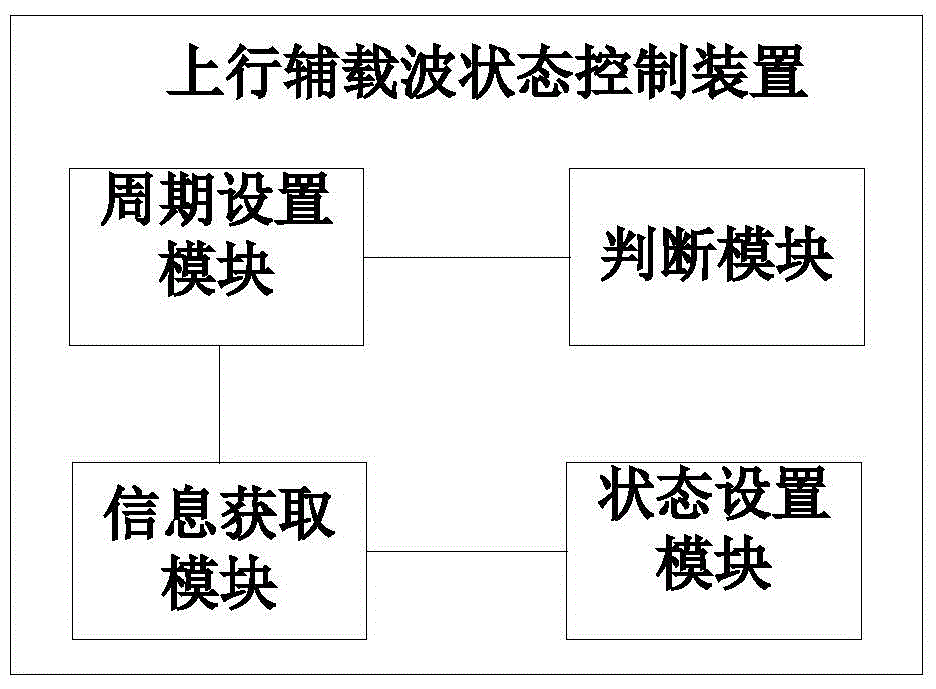Uplink auxiliary carrier state control method, uplink auxiliary carrier state control device and base station
A state control and secondary carrier technology, applied in the field of communication, can solve the problems of consumption and the reduction of the number of ordinary users, and achieve the effect of saving consumption and saving consumption
- Summary
- Abstract
- Description
- Claims
- Application Information
AI Technical Summary
Problems solved by technology
Method used
Image
Examples
Embodiment 1
[0047] Through research, it is found that when the user terminal UE does not need to send data (that is, when there is no traffic demand), or the demand is small, activating the secondary carrier of the UE does not contribute to the throughput. When the remaining transmit power of the user terminal is insufficient (that is, when the power demand is too large), the DPCCH transmit power of the secondary carrier will not only affect the service available power of the primary carrier, but also increase the interference of the uplink secondary carrier frequency; therefore, for the uplink For a user terminal whose secondary carrier has been activated, it is more reasonable to deactivate its uplink secondary carrier if the demand for data transmission decreases or the remaining transmit power decreases.
[0048] In addition, when the load of the uplink secondary carrier cell associated with the user terminal is high, the gain brought by the activation of the uplink secondary carrier t...
Embodiment 2
[0073] This embodiment provides an apparatus for controlling the state of an uplink secondary carrier. The apparatus for controlling the state of an uplink secondary carrier may be integrated into a base station for implementation. Please refer to figure 2 shown, including: an information acquisition module and a state setting module;
[0074] The information acquisition module is used to acquire the demand status of the user terminal and the load status of the uplink secondary carrier cell associated with the user terminal;
[0075]The state setting module is used to set the activation state of the uplink auxiliary carrier of the user terminal according to the demand state of the user terminal and the load state of the uplink auxiliary carrier cell.
[0076] The uplink auxiliary carrier state control device can ensure that the user terminal activates the uplink auxiliary carrier when it is necessary and has little impact on system performance, and deactivates the uplink auxi...
Embodiment 3
[0088] This embodiment provides a base station, please refer to Image 6 As shown, it includes a memory and a processor; the memory is used to store at least one program module, and the processor is used to call the at least one program module to execute the steps in the method for controlling the state of the uplink auxiliary carrier in the above-mentioned embodiment.
[0089] In order to better understand the present invention, the following takes the base station as the execution subject and takes several specific application scenarios as examples to further illustrate the present invention.
[0090] See Figure 7 As shown, the process of uplink secondary carrier state setting and resource allocation includes:
[0091] Step 701: the base station determines whether the user terminal is activated or deactivated when the current uplink secondary carrier is activated, and sets a deactivation determination period or an activation determination period based on the determination ...
PUM
 Login to View More
Login to View More Abstract
Description
Claims
Application Information
 Login to View More
Login to View More - R&D
- Intellectual Property
- Life Sciences
- Materials
- Tech Scout
- Unparalleled Data Quality
- Higher Quality Content
- 60% Fewer Hallucinations
Browse by: Latest US Patents, China's latest patents, Technical Efficacy Thesaurus, Application Domain, Technology Topic, Popular Technical Reports.
© 2025 PatSnap. All rights reserved.Legal|Privacy policy|Modern Slavery Act Transparency Statement|Sitemap|About US| Contact US: help@patsnap.com



